Household pests
Home /
Household pests
Cockroaches
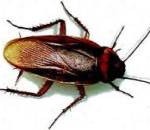
German cockroach (Blatella germanica)
The cockroach is, on average, a 8–15 mm long reddish brown insect with a slim and relatively flat body, it has two pairs of leathery wings, tightly pressed against the back. A female cockroach can only be distinguished from a male during breeding. The female packs her eggs in a rectangular pouch called the oocyte. The oocyte contains up to 30 eggs. In nature, they are omnivorous forest dwellers that feed on decomposing animal and plant remains. In homes, they feed on food waste, and in the absence of a better option, cockroaches can eat wallpaper glue and paper. In Estonia, cockroaches can also be found in larger waste dumps. As cockroaches get into all sorts of places (waste bin, dirty floor, toilet, etc.), various pathogens can stick to their bodies. Cockroaches can spread parasitic eggs, salmonellosis, infectious hepatitis, anthrax, tuberculosis and various fungal diseases. If there is enough water and food, an adult cockroach lives for 40 days.
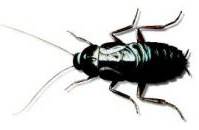
Oriental cockroach (Blatta orientalis)
Adults are 20–24 mm long, dark brown to black in colour. The wings of the male cover two-thirds of the abdomen, the wings of the female are vestigial. They are able to climb a rough vertical surface. At 250 °C, adults live for about 4.5 months.
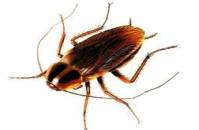
American cockroach (Periplaneta Americana)
Adults are 28–35 mm long, reddish brown with yellow markings, forewings without yellow edges, the last body segment is twice as long as it is wide. The cockroach comes from Africa but feels very much at home in America.
Ants
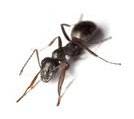
Black garden ant (Lasius niger)
The black garden ant is the most common indoor species. Their nest is usually located outdoors: in turf, flower beds, under tiles, stones and timber material, or by the base of the house. They invade in spring and summer in search of food. If black garden ants are also present in winter, it is because their nest is either within the structure of the house, under the house or in its immediate vicinity. The warmth of the building usually keeps the hibernating black garden ants awake all year round. Black garden ants are harmless by themselves, but still unpleasant, invading wherever food (mostly sweet) can be found.
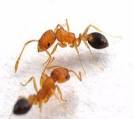
Pharaoh ant (Monomorium pharaonis)
The pharaoh ant originates from regions bordering North Africa and the Mediterranean Sea. They are widespread all over the world. The need for warmth and moisture forces them to live inside buildings. Insects can be found in very different places – for example, in residential buildings, hotels, hospitals, catering establishments and other institutions. The pharaoh ant is omnivorous, although it prefers protein-rich substances. They damage goods and their bite can be dangerous to health. Control is a difficult and time-consuming process for the pharaoh ant, as it is not susceptible to most control agents. For successful control, it is necessary to install bait toxins on their tracks and in the immediate vicinity.
Bloodsucking insects
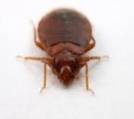
Bed bug (Cimex lectularius)
Adults are 5 mm long, reddish brown in colour, turning purplish red after feeding; well-developed antennae; protruding eyes; clawed feet that allow movement on rough, non-slippery surfaces; ratio of head width (including eyes) to length (to the third segment of the antenna) usually greater than 1.7. Mainly parasitises on humans, although it can also live on warm-blooded animals. Found in human settlements worldwide.
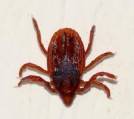
Tick (Ixodes ricinus)
Adult female ticks have a 3–3.5 mm long highly elastic, oval and flattened outer skeleton allowing them to expand several times as they feed, taking on an ovoid shape. Males are 2 mm long and their outer skeleton does not increase significantly when sucking blood. Ticks are major spreaders of infectious diseases. Two species of ticks are common in Estonia: the castor bean tick (Ixodes ricinus) and the Taiga tick (Ixodes persulcatus), which spreads tick-borne encephalitis. Ticks transmit plague, typhus, tularaemia, spring summer encephalitis, Lyme disease, bovine babesiosis and other diseases. They spread diseases by viruses, bacteria, blood parasites and other pathogens. The castor bean tick prefers moist and shady places to live, so it is often found in sparse mixed and deciduous forests with dense undergrowth, forest edges and wooded meadows. The Taiga tick is common in primeval coniferous and mixed forests. An active tick often lurks on a blade of grass a few tens of centimetres above ground and waits for a suitable victim to pass by.

Human flea (Pulex irritans)
Adult fleas are 2–3.5 mm long; no setae on chins and chest; the main part of the legs covered with strong spikes. Mainly parasitises on humans, can also be found on pigs, hedgehogs, foxes and badgers; lives in the host’s bedroom.
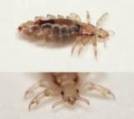
Head louse (Pediculus capitis)
The head louse is a parasite visible to the naked eye that lives only on a person’s head and feeds on blood that it sucks through the scalp. The life span of a louse is 15–35 days and one louse can lay nearly 100 eggs. The greyish, dry, lustreless nits found about 1 cm from the scalp are usually already dead or empty shells. A louse cannot live for more than 24 hours without food. The lethal temperature for lice is below 22 and above 44 °C. Nits can survive on a comb or on clothes for a month. The saliva and excrement of the parasites have an allergenic effect and cause irritation.

Cat flea (Ctenocephalides felis)
Adult fleas are 2–3.3 mm long; the length of the front of the head is greater than the height; the anterior segment of the chest and jaws are covered with strong multi-row setae (first teeth nearly as long as the second); the main part of the legs equipped with strong spikes. Mainly parasitises on species belonging to the feline family as well as on dogs, other animals and humans, mainly in sleeping areas. Stray cats bring the cat flea into buildings.
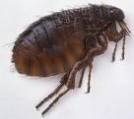
Dog flea (Ctenocephalides canis)
Adult fleas are 2–3.3 mm long; the length and height of the front part of the head are the same; protruding row of strong setae on the jaws and the front segment of the chest (front teeth half the length of the back teeth); the main part of the legs equipped with strong spikes. Mainly parasitises on species belonging to the Canidae family as well as on domestic animals and humans; nests in sleeping areas.
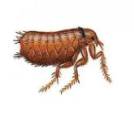
Hen flea (Ceratophyllus gallinae)
Adult fleas are generally brown and 1–8 mm long. Their eyes and antennae are prominent. Their mouths are well adapted to pierce the skin and suck blood and are downwards in relation to the head. This species is the most common bird flea, hen flea. The hen flea lives indoors only for a short time and only in nests. They reproduce during the breeding season when the host and/or juveniles are available for regular blood meals. Adult hen fleas live in birds’ nests. When birds leave the nest, the adult fleas have to find a new host. When the nest is used again, the pupae hatch, mate, and continue the reproductive cycle. Hen fleas can breed in huge numbers in chicken coops, breeder reactors, cells, etc.
Spiders
A spider is not an insect, but merely a very distant relative of one. Spiders belong to the Arachnid genus, along with scorpions, harvestmen, pseudoscorpions and mites (which also include ticks).
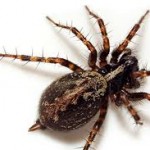
Domestic house spider (Degenaria domestica)
This spider lives in houses. The female spider is up to 2 cm long, yellowish brown, the male is about half as long.
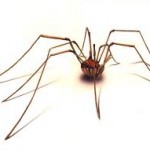
Harvestman (Phalangium opilio)
Harvestmen are relatives of spiders. They can be found on house walls, basements, wood sheds and elsewhere from mid-July to late autumn, but hibernating specimens are sometimes encountered as late as early spring. The legs of some species, not those found in Estonia, are up to 25 times longer than the body.
Flies
It is an extremely species-rich suborder of dipterans. They have adapted to live everywhere and feed on organic matter, no matter its form. Fly larvae can be found in living plant and animal organisms, animal manure as well as decaying plant remains and decomposing corpses.

Housefly (Musca domestica)
Prefers to live in human settlements where there is enough food. The imagoes feed on a variety of foods that contain proteins and sugars. The housefly has adapted to feed on both liquid and solid foods. During the summer, it lays up to 150 eggs at a time for a total of 5–6 times on manure or other waste suitable for food. A single female housefly can theoretically have up to 5 trillion offspring per year. The housefly is a well-known carrier of pathogens because they do not die in the fly’s gut.


Blow fly (Calliphora, Lucilia)
Blue or green flies with a metallic sheen of tropical origin appear quite quickly, you just have to start cleaning fish or leave a piece of meat on the table for a moment. The blow fly lays rather large, whitish yellow elongated eggs on a piece of meat. The larvae that have hatched begin to destroy the food. Development of the larvae takes from ten days to three weeks. In nature, the purpose of these flies is to destroy animal carcasses. Blue bottle flies and green bottle flies are carriers of microbes and parasite eggs.

Fruit fly (Drosophila)
A 1–4 mm long insect belonging to the Drosophilidae family. They are tiny yellow flies, often with red eyes. The flies feed on the fermenting juice and then lay their eggs on the fruit. One small fly can lay up to 50 eggs per day, and up to 500 eggs in its lifetime. The development of larvae is very fast and depends significantly on the temperature. It takes 8–10 days for the imago to hatch at temperature of about 25 °C.
